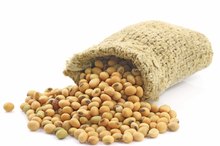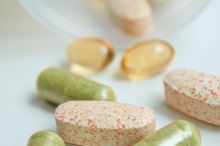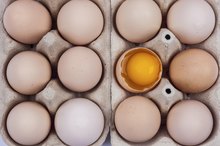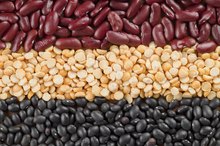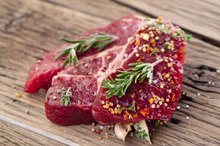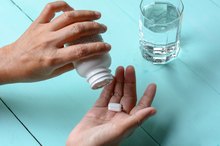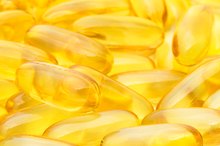Lecithin & Liver Function
Lecithin protects the health of your liver several ways 8. It's a special type of lipid that prevents fats from accumulating in the liver. Plus lecithin is an important source of the nutrient choline, which has a vital role in liver function. Lecithin is the common name for phosphatidylcholine, so the two names are often used interchangeably.
Lecithin Overview
Lecithin belongs to a group of compounds called phospholipids, which build the membranes surrounding every cell in your body. In fact, lecithin is one of the primary constituents in cell membranes. In this role, it helps regulate the way cells work and supports communication between cells.
You can tell from its scientific name -- phosphatidylcholine -- that lecithin contains choline. It’s actually the biggest source of choline in a typical diet. Choline is an essential nutrient; in addition to its role in the liver, it supports metabolism and helps make the neurotransmitter acetylcholine.
- Lecithin belongs to a group of compounds called phospholipids, which build the membranes surrounding every cell in your body.
Role of Lecithin in Liver
Lecithin Granules for Weight Loss
Learn More
Lecithin regulates fat metabolism in the liver, where it binds with proteins that lower triglycerides and boost levels of good cholesterol in the bloodstream. The liver needs phosphatidylcholine to produce very-low-density lipoproteins, which carry fats from the liver.
If levels of phosphatidylcholine are low, fats build up in the liver, eventually causing liver damage. People tend to develop nonalcoholic fatty liver disease if they don’t have enough choline, reports the Linus Pauling Institute 2.
In laboratory studies using mice, liver damage was significantly reduced when the mice received soybean lecithin, according to a report published in Pediatric Research in February 2007. Another study using rats found that dietary phosphatidylcholine reduced fatty buildup in the liver, reported Nutrition in 2005 4.
- Lecithin regulates fat metabolism in the liver, where it binds with proteins that lower triglycerides and boost levels of good cholesterol in the bloodstream.
- The liver needs phosphatidylcholine to produce very-low-density lipoproteins, which carry fats from the liver.
Sources of Lecithin
Most of the choline in foods exists in the form of lecithin. As a result, sources of lecithin are often reported as choline-containing foods.
With 356 milligrams in a 3-ounce serving, beef liver is the top source of choline. It's followed by egg yolks, which have 147 milligrams of choline in one large yolk. Lean beef, chicken breast, salmon, scallops, shrimp and Atlantic cod supply 70 to 100 milligrams in a 3-ounce serving.
Brussels sprouts and broccoli are two good veggies, with about 63 grams of choline in 1 cup of cooked veggies. Soy milk and tofu are also good sources, and you’ll get smaller amounts from skim milk, peanut butter, pinto beans, oats and whole-wheat bread.
- Most of the choline in foods exists in the form of lecithin.
- With 356 milligrams in a 3-ounce serving, beef liver is the top source of choline.
Recommendations and Warnings
Side Effects of Lecithin Supplements
Learn More
The Institute of Medicine recommends that women get 425 milligrams of choline daily, while men need 550 milligrams 2. On the flip side, the IOM advises against consuming more than 3,500 milligrams of choline daily because it may cause a drop in blood pressure.
You may experience a stomachache or diarrhea from taking supplemental lecithin or choline. More serious side effects are less likely with lecithin because it’s only about 13 percent choline. Pure supplemental choline can cause vomiting, sweating and a fishy body odor.
If you’re pregnant or breast-feeding, talk to your doctor to be sure choline supplements are safe. Don’t take choline if you’re diagnosed with bipolar disorder because it may increase the risk of depression.
- The Institute of Medicine recommends that women get 425 milligrams of choline daily, while men need 550 milligrams 2.
- On the flip side, the IOM advises against consuming more than 3,500 milligrams of choline daily because it may cause a drop in blood pressure.
Related Articles
References
- Linus Pauling Institute: Choline
- Pediatric Research: Dietary Lecithin Protects Against Cholestatic Liver Disease in Cholic Acid-Fed Abcb-4-Deficient Mice
- Nutrition: Dietary Phosphatidylcholine Alleviates Fatty Liver Induced by Orotic Acid
- Gate2Biotech: Lecithin Found to Have Beneficial Effects on Fat Metabolism
- VeganHealth.org: Choline
- University of Utah Health Care: Choline
- University of Utah Health Care: Lecithin
- Gibb AJ. Choline and acetylcholine: what a difference an acetate makes! J Physiol (Lond). 2017;595(4):1021-1022. doi:10.1113/JP273666
- Zeisel SH, Da Costa KA. Choline: an essential nutrient for public health. Nutr Rev. 2009;67(11):615-23. doi:10.1111/j.1753-4887.2009.00246.x
- Nurk E, Refsum H, Bjelland I, et al. Plasma free choline, betaine and cognitive performance: the Hordaland Health Study. Br J Nutr. 2013;109(3):511-9. doi:10.1017/S0007114512001249
- Bertoia ML, Pai JK, Cooke JP, et al. Plasma homocysteine, dietary B vitamins, betaine, and choline and risk of peripheral artery disease. Atherosclerosis. 2014;235(1):94-101. doi:10.1016/j.atherosclerosis.2014.04.010
- Fischer LM, Dacosta KA, Kwock L, et al. Sex and menopausal status influence human dietary requirements for the nutrient choline. Am J Clin Nutr. 2007;85(5):1275-85. doi:10.1093/ajcn/85.5.1275
- Caudill MA. Pre- and postnatal health: evidence of increased choline needs. J Am Diet Assoc. 2010;110(8):1198-206. doi:10.1016/j.jada.2010.05.009
- Da costa KA, Gaffney CE, Fischer LM, Zeisel SH. Choline deficiency in mice and humans is associated with increased plasma homocysteine concentration after a methionine load. Am J Clin Nutr. 2005;81(2):440-4. doi:10.1093/ajcn.81.2.440
- Sherriff JL, O'Sullivan TA, Properzi C, Oddo JL, Adams LA. Choline, Its Potential Role in Nonalcoholic Fatty Liver Disease, and the Case for Human and Bacterial Genes. Adv Nutr. 2016;7(1):5-13. doi:10.3945/an.114.007955
- NIH Office of Dietary Supplements. Choline. Updated July 9, 2019.
- Zheng Y, Li Y, Rimm EB, et al. Dietary phosphatidylcholine and risk of all-cause and cardiovascular-specific mortality among US women and men. Am J Clin Nutr. 2016;104(1):173-80. doi:10.3945/ajcn.116.131771
- Institute of Medicine (US) Standing Committee on the Scientific Evaluation of Dietary Reference Intakes and its Panel on Folate, Other B Vitamins, and Choline. Dietary Reference Intakes for Thiamin, Riboflavin, Niacin, Vitamin B6, Folate, Vitamin B12, Pantothenic Acid, Biotin, and Choline. Washington (DC): National Academies Press (US); 1998.
- Bertoia ML, Pai JK, Cooke JP, et al. Plasma homocysteine, dietary B vitamins, betaine, and choline and risk of peripheral artery disease. Atherosclerosis. 2014 Jul;235(1):94-101.
- Caudill MA. Pre- and postnatal health: evidence of increased choline needs. J Am Diet Assoc. 2010 Aug;110(8):1198-206.
- Fischer LM, daCosta KA, Kwock L, et al. Sex and menopausal status influence human dietary requirements for the nutrient choline. Am J Clin Nutr. 2007 May;85(5):1275-85.
- Nurk E, Refsum H, Bjelland I, et al. Plasma free choline, betaine and cognitive performance: the Hordaland Health Study. Br J Nutr. 2013 Feb 14;109(3):511-9.
- Zheng Y, Li Y, Rimm EB, et al. Dietary phosphatidylcholine and risk of all-cause and cardiovascular-specific mortality among US women and men. Am J Clin Nutr. 2016 Jul;104(1):173-80.
Writer Bio
Sandi Busch received a Bachelor of Arts in psychology, then pursued training in nursing and nutrition. She taught families to plan and prepare special diets, worked as a therapeutic support specialist, and now writes about her favorite topics – nutrition, food, families and parenting – for hospitals and trade magazines.

